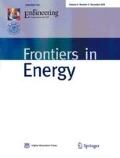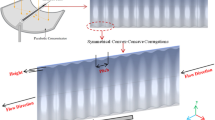Abstract
Parabolic trough receiver is a key component to convert solar energy into thermal energy in the parabolic trough solar system. The heat loss of the receiver has an important influence on the thermal efficiency and the operating cost of the power station. In this paper, conduction and radiation heat losses are analyzed respectively to identify the heat loss mechanism of the receiver. A 2-D heat transfer model is established by using the direct simulation Monte Carlo method for rarefied gas flow and heat transfer within the annulus of the receiver to predict the conduction heat loss caused by residual gases. The numerical results conform to the experimental results, and show the temperature of the glass envelope and heat loss for various conditions in detail. The effects of annulus pressure, gas species, temperature of heat transfer fluid, and annulus size on the conduction and radiation heat losses are systematically analyzed. Besides, the main factors that cause heat loss are analyzed, providing a theoretical basis for guiding the improvement of receiver, as well as the operation and maintenance strategy to reduce heat loss.
Similar content being viewed by others
Abbreviations
- c r :
-
Relative velocity
- C 0 :
-
−0.57
- C 1 :
-
6.8/(g·mol−1)
- d :
-
Molecular diameter
- I 0 :
-
First kind zero order modified Bessel function
- Kn:
-
Knudsen number
- L :
-
Characteristic length of the space/mm
- M *g :
-
The molar mass for monatomic gases, 1.4 times the molar mass for diatomic/polyatomic gases
- p :
-
Average pressure of gas in annulus/Pa
- \({Q_{\rm{c}}}\prime \) :
-
Model values of conduction heat transfer rate from absorber tube to glass envelope/(W·m−1)
- Qc:
-
Conduction heat transfer rate from the absorber tube to glass envelope/(W·m−1)
- Q cond,abs :
-
Conduction heat transfer rate through the absorber tube wall /(W·m−1)
- Q cond,g :
-
Conduction heat transfer rate through the glass envelope wall /(W·m−1)
- Q loss :
-
Total heat loss rate from the PTR to the surroundings/(W·m−1)
- Q obtain :
-
Heat obtained by HT/(W·m−1)
- Q r :
-
Radiation heat transfer rate from the absorber tube to glass envelope/(W·m−1)
- Q solar :
-
Solar irradiation rate into the absorber pipe/(W·m−1)
- R :
-
Radius/mm
- r :
-
Heat transfer resistance
- T :
-
Temperature
- T0:
-
273 K
- u :
-
Normal velocity
- v :
-
Tangential velocity
- α:
-
Thermal accommodation coefficient
- αt :
-
Accommodation coefficient of the kinetic energy of the tangential velocity component
- αn :
-
Energy accommodation coefficient of the normal velocity component
- εg :
-
Emissivity of glass envelope
- εs :
-
Emissivity of solar selective coatings
- εt :
-
Relative translational energy
- \(\mathcal{R}\) :
-
Scatter kernel
- Λ:
-
Molecular mean free path/mm
- μ:
-
Viscosity
- σ:
-
Stefan-Boltzmann constant, 5.67×10−8 W/(m2·K4)
- σT :
-
Total cross section
- ω:
-
Viscosity temperature index
- abs,o:
-
Outer surface of absorber tube
- g,i:
-
Inner surface of glass envelope
- g,o:
-
Outer surface of glass envelope
- i:
-
Incident flows
- r:
-
Reflected flows
- ref:
-
When the relative velocity is cr,ref
- s:
-
Surface
References
Espinosa-Rueda G, Navarro Hermoso J, Martínez-Sanz N, Gallas-Torreira M. Vacuum evaluation of parabolic trough receiver tubes in a 50 MW concentrated solar power plant. Solar Energy, 2016, 139: 36–46
Liu J, Lei D, Li Q. Vacuum lifetime and residual gas analysis of parabolic trough receiver. Renewable Energy, 2016, 86: 949–954
Daniel P, Joshi Y, Das A K. Numerical investigation of parabolic trough receiver performance with outer vacuum shell. Solar Energy, 2011, 85(9): 1910–1914
Lobón D, Valenzuela L, Baglietto E. Modeling the dynamics of the multiphase fluid in the parabolic-trough solar steam generating systems. Energy Conversion and Management, 2014, 78(78): 393404
Ren Y, Lei D, Wang Z. Experimental analysis of residual gas of vacuum annulus in parabolic through solar receivers. In: AIP Conference Proceedings 2126, 2019, 120017: 1–10
He Y, Wang K, Qiu Y, Du B, Liang Q, Du S. Review of the solar flux distribution in concentrated solar power: non-uniform features, challenges, and solutions. Applied Thermal Engineering, 2019, 149: 448–474
Reddy K, Balaji S, Sundararajan T. Heat loss investigation of 125 kWth solar LFR pilot plant with parabolic secondary evacuated receiver for performance improvement. International Journal of Thermal Sciences, 2018, 125: 324–341
Kearney D, Price H. Chapter 6: Recent Advances in Parabolic Trough Solar Power Plant Technology. Boulder Co American Solar Energy Society Inc, 2005
Kutscher C, Mehos M, Turchi C, Glatzmaier G. Line-focus solar power plant cost reduction plan (milestone report). Office of Scientific & Technical Information Technical Reports, 2010
Lei D, Fu X, Ren Y, Yao F, Wang Z. Temperature and thermal stress analysis of parabolic trough receivers. Renewable Energy, 2019, 136: 403–413
Li J, Wang Z, Lei D, Li J. Hydrogen permeation model of parabolic trough receiver tube. Solar Energy, 2012, 86(5): 1187–1196
Price H, Forristall R, Wendelin T, Lewandowski A, Moss T, Gummo C. Field survey of parabolic trough receiver thermal performance. In: Proceedings of ISEC2006: ASME International Solar Energy Conference, Denver, Colorado, USA, 2006
Prahl C, Röger M, Stanicki B, Hilgert C. Absorber tube displacement in parabolic trough collectors—a review and presentation of an airborne measurement approach. Solar Energy, 2017, 157(157): 692–706
Ratzel A C, Hickox C E, Gartling D K. Techniques for reducing thermal conduction and natural convection heat losses in annular receiver geometries. Journal of Heat Transfer, 1979, 101(1): 108113
Tang Z, Zhao X P, Li Z Y, Tao W Q. Multi-scale numerical analysis of flow and heat transfer for a parabolic trough collector. International Journal of Heat and Mass Transfer, 2017, 106: 526538
Roesle M, Good P, Coskun V, Steinfeld A. Analysis of conduction heat loss from a parabolic trough solar receiver with active vacuum by direct simulation Monte Carlo. Numerical Heat Transfer, 2012, 62(5): 432–444
Burkholder F, Brandemuehl M, Kutscher C, Wolfrum Ed. Heat conduction of inert gas-hydrogen mixtures in parabolic trough receivers. In: ASME 2008, International Conference on Energy Sustainability Collocated with the Heat Transfer, Fluids Engineering, and Energy Nanotechnology Conferences, Jacksonville, Florida, USA, 2008: 449–458
Yu Q, Mi J, Lang Y, Du M, Li S, Yang H, Hao L, Liu X, Jiang L. Thermal properties of high temperature vacuum receivers used for parabolic trough solar thermal power system. Progress in Natural Science: Materials International, 2017, (27): 410–415
Setien E, López-Martín R, Valenzuela L. Methodology for partial vacuum pressure and heat losses analysis of parabolic troughs receivers by infrared radiometry. Infrared Physics & Technology, 2019, 98: 341–353
Yao F, Lei D, Yu K, Han Y, Yao P, Wang Z, Fang Q, Hu Q. Experimental study on vacuum performance of parabolic trough receivers based on a novel non-destructive testing method. Energies, 2019, 12(23): 4531
Kumar D, Kumar S. Simulation analysis of overall heat loss coefficient of parabolic trough solar collector at computed optimal air gap. Energy Procedia, 2017, 109: 86–93
Lei D, Li Q, Wang Z, Li J, Li J. An experimental study of thermal characterization of parabolic trough receivers. Energy Conversion and Management, 2013, 69(5): 107–115
Hilgert C, Jung C, Wasserfuhr C, Leon J, Valenzuela L. Qualification of silicone based HTF for parabolic trough collector applications. In: AIP Conference Proceedings 2126, 2019, 080003: 1–10
Chang C, Sciacovelli A, Wu Z, Li X, Li Y, Zhao M, Deng J, Wang Z, Ding Y. Enhanced heat transfer in a parabolic trough solar receiver by inserting rods and using molten salt as heat transfer fluid. Applied Energy, 2018, 220: 337–350
Nunes V, Queirós C, Lourenço M, Santos F J V, Nieto de Castro C A. Molten salts as engineering fluids — a review: Part I. Molten alkali nitrates. Applied Energy, 2016, 183: 603–611
Muñoz-Anton J, Biencinto M, Zarza E, Díez L E. Theoretical basis and experimental facility for parabolic trough collectors at high temperature using gas as heat transfer fluid. Applied Energy, 2014, 135: 373–381
Aguilar R, Valenzuela L, Avila-Marin A L, Garcia-Ybarra P L. Simplified heat transfer model for parabolic trough solar collectors using supercritical CO2. Energy Conversion and Management, 2019, 196: 807–820
Qiu Y, Li M, He Y, Tao W. Thermal performance analysis of a parabolic trough solar collector using supercritical CO2 as heat transfer fluid under non-uniform solar flux. Applied Thermal Engineering, 2017, 115: 1255–1265
Wu Z, Lei D, Yuan G, Shao J, Zhang Y, Wang Z. Structural reliability analysis of parabolic trough receivers. Applied Energy, 2014, 123: 232–241
Forristall R. Heat transfer analysis and modeling of a parabolic trough solar receiver implemented in engineering equation solver. National Renewable Energy Lab., Golden, CO. (US), Technical Report, 2003, NREL/TP-550-34169
Shen C. Rarefied Gas Dynamics. Springer Nature, 2005, 17(5): 9091
Bird G. Molecular Gas Dynamics and the Direct Simulation of Gas Flows. Oxford: Clarendon Press, 1994
Bird G, Gallis M, Torczynski J, Rader D J. Accuracy and efficiency of the sophisticated direct simulation Monte Carlo algorithm for simulating non-continuum gas flows. Physics of Fluids, 2009, 21(1): 541–546
Song S, Yovanovich M. Correlation of thermal accommodation coefficient for engineering surfaces. In: Proceedings of the 24th National Heat Transfer Conference and Exhibition, Pittsburgh, PA, USA, 1987: 107–116
Burkholder F. Transition regime heat conduction of argon/hydrogen and xenon/hydrogen mixtures in a parabolic trough receiver. Dissertation for the Docotoral Degree. Boulder: University of Colorado Boulder, 2011
Acknowledgements
This work was funded by the National Key R&D Program of China (No. 2019YFE0102000) and the National Natural Science Foundation of China (Grant No. 51476165).
Author information
Authors and Affiliations
Corresponding author
Rights and permissions
About this article
Cite this article
Lei, D., Ren, Y. & Wang, Z. Numerical study of conduction and radiation heat losses from vacuum annulus in parabolic trough receivers. Front. Energy 16, 1048–1059 (2022). https://doi.org/10.1007/s11708-020-0670-7
Received:
Accepted:
Published:
Issue Date:
DOI: https://doi.org/10.1007/s11708-020-0670-7




